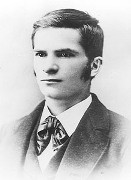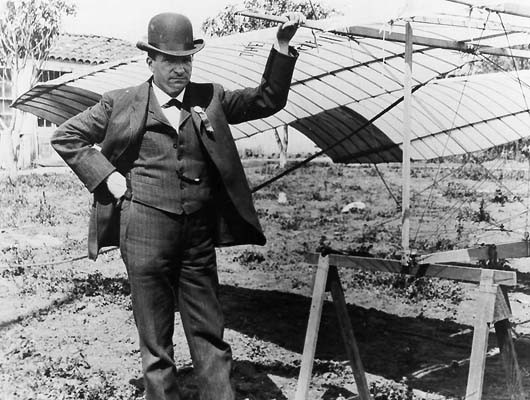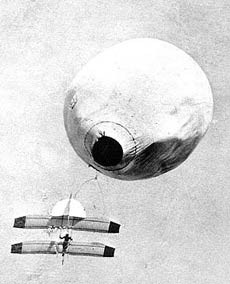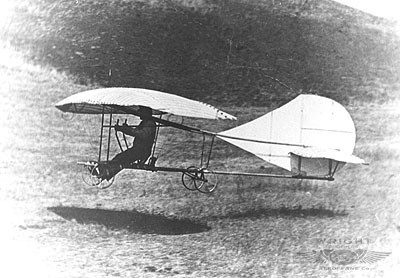John J. Montgomery
2001
about
(1858-1911) Early Pioneer; First American to Build and Fly a Man-Carrying Glider; Controlled Glider Flights 1884; Balloon Launches
Bio

John Montgomery was born in Yuba City, California and became interested in flight at a young age. He and his father Zachariah were special guests at the flight of America's first unmanned untethered dirigible - Frederick Marriott's "Avitor Hermes Jr." in 1869. John excelled in math and physics and he theorized that the physics of fluid dynamics developed for water-based systems could be applied to aerial navigation.
The Montgomery family relocated to Otay, California near San Diego in 1882. It was here that John began observing large soaring birds. He experimented with a series of three ornithopters and three manned, fixed-wing gliders in 1883-1886. The structure and control systems of the gliders were based on ornithology and controlled laboratory experiments. The first glider was flown under control in 1884. Each subsequent glider used different airfoils, control systems, and launching methods. Through these tests John became the first person in the Western Hemisphere to fly in a heavier-than-air flying machine in a controlled fashion. Through investigations with a whirling arm, water tank, and smoke chamber John was able to understand the distribution and movement of pressures on surfaces, and the importance of a cambered wing in obtaining lift.
In 1893, John attended the International Conference on Aerial Navigation in Chicago and presented lectures to the audience on his theories and the nature of soaring flight, as well as descriptions of his experiments. He befriended Octave Chanute and others. Subsequently John took a teaching position at Mt. St. Joseph's College in Rohnerville, California continuing his studies of aerodynamics through controlled experiments using a water current tank and crude wind tunnel. These experiments culminated in 1894 with a theory of how lift was generated on a cambered wing surface through a circulation of flow around the wing.

In 1903, John was introduced to Thomas Baldwin who was experimenting with airships. Through his knowledge of aerodynamics, Montgomery instructed Baldwin in the development of aeronautical propellers. Baldwin suggested the opportunity to launch gliders from hot-air balloons at high altitudes. Together they signed a contract, setting Montgomery towards a new series of manned tandem-wing gliders capable of fully controlled, sustained glides from altitude. Baldwin on the other hand, immediately adopted Montgomery's propellers as his own invention, winning a large monetary prize for the best dirigible performance at the 1904 St. Louis World's Fair. Infuriated, Montgomery set off to establish his priority in aeronautics by "going public."

In 1905, Montgomery hired and trained Daniel Maloney to be his aeronaut. A new tandem-wing design was thoroughly tested, first with model gliders, then as a kite, then with free flight unmanned ballasted tests of a full-size glider, then with mockups of the control system, leading to the construction of The Santa Clara glider. This aircraft was used for the first public demonstration of heavier-than-air flying machine in America in April 1905 at Santa Clara College where Montgomery was a physics professor. Maloney was released from the balloon at 4,000 feet and glided in perfectly controlled circles to a gentle landing. Montgomery and Maloney proceeded to make a series of demonstrations in the Bay Area in 1905, leading to an unfortunate crash that killed Maloney. Montgomery built a new series of gliders and trained new aeronauts to fly those machines for additional demonstrations.

In 1911 Montgomery began experimenting with a new type of glider - one where all of the control was in the wing and the tail was completely fixed. This glider, The Evergreen, was flown by Montgomery and another aeronaut Reinhardt for over 50 flights from the hills east of San Jose, California in October of 1911. Tragically on October 31, 1911, Montgomery was flying in The Evergreen at low altitude and low speed and encountered a dust devil strong enough to generate a tip stall and the glider crashed nose first into the ground. Montgomery died at the site due to his injuries. Through his continued experiments Montgomery helped convert gliding from a fantasy to a well-defined and understood science. He understood the importance of parabolic airfoils far earlier than most, and helped inspire a generation of aviators to use gliders for science and recreation as America's first glider pilot.
Reference:
Quest for Flight John J. Montgomery and the Dawn of Aviation in the West
by Craig S. Harwood and Gary B. Fogel 2012